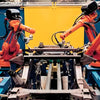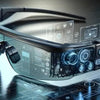Exploring TOF Gesture Recognition: Future of Contactless Interaction

How Does TOF Gesture Recognition Make Contactless Interaction Smarter?
With the proliferation of smart devices and the pursuit of safer, more intuitive human-machine interfaces, contactless interaction has emerged as a defining direction in next-generation technology. At the core of this transformation lies TOF (Time-of-Flight) gesture recognition, a 3D sensing technology that precisely captures spatial depth and motion to enable natural, touch-free control across smart homes, automotive systems, VR/AR environments, and more.
This article explores the fundamentals of TOF gesture recognition, its application scenarios, technical bottlenecks, and future development trends.
1. Understanding Non-Contact Distance Measurement in TOF Gesture Recognition
Non-contact distance measurement is a sensing method that determines object distance without physical touch. In TOF-based systems, including both DTOF (Direct Time-of-Flight) and ITOF (Indirect Time-of-Flight) architectures, sensors emit modulated light pulses and measure the time or phase shift of the returning light. This information is converted into precise 3D spatial data, allowing devices to recognize hand movements and gestures with millimeter accuracy.
In the realm of gesture recognition, TOF sensors continuously map the spatial relationship between the user’s hand and the device, enabling seamless real-time motion tracking without touching the screen or buttons. The balance between accuracy (closeness to true distance) and precision (consistency of measurements) is essential to ensure reliable gesture detection. Likewise, the field of view (FOV) of a TOF sensor determines the effective range of gesture detection.
Beyond interactive devices, similar TOF distance measurement techniques are also applied in scientific imaging instruments such as electron microscopes, where sub-micrometer precision enables detailed material analysis.
Ultimately, TOF-based non-contact distance measurement serves as the technological foundation for the new era of touchless, intelligent human-computer interaction.
2. Evolution of Contactless Interaction and Its Application Background
As digital transformation accelerates, people increasingly expect contact-free, safe, and efficient ways to interact with technology. The global pandemic further underscored the importance of reducing physical contact in both personal and public spaces, accelerating the deployment of TOF gesture recognition systems.
-
Smart Homes: Users can wave or swipe to control lighting, appliances, or temperature adjustments without physical switches. TOF gesture recognition not only enhances convenience but also reduces the spread of germs in shared environments.
-
Automotive Systems: In vehicles, drivers can control multimedia, navigation, or air conditioning through hand gestures, minimizing distraction and improving driving safety.
-
Healthcare Environments: Doctors can navigate medical imaging interfaces or equipment using gestures, maintaining sterility and operational efficiency during procedures.
From household appliances to medical devices, TOF 3D sensing allows human gestures to replace buttons, delivering a clean, safe, and natural interaction experience.
3. Working Principles of TOF Gesture Recognition
At its core, TOF gesture recognition relies on measuring the time-of-flight of infrared light pulses. The light emitted from the sensor reflects off the user’s hand and returns to the detector, allowing the system to calculate depth at each pixel. The resulting 3D point cloud reconstructs the hand’s spatial position and movement in real time.
Compared with traditional 2D vision systems, TOF offers key advantages:
-
Accurate Depth Perception: TOF can capture fine details such as finger bending or rotation, supporting natural gestures like grabbing, pinching, and zooming.
-
Lighting Independence: Unlike RGB-based gesture systems, TOF sensors use infrared light and perform reliably under various lighting conditions.
-
Low Latency and Real-Time Tracking: Modern TOF cameras, supported by hardware acceleration and AI-based algorithms, deliver rapid response times suitable for fast or multi-finger gestures.
This precise 3D sensing capability enables TOF systems to overcome the limitations of 2D gesture recognition and support a more immersive, responsive interaction model.
4. Real-World Applications of TOF Gesture Recognition
TOF gesture recognition is now widely integrated into consumer electronics and industrial systems, enhancing user experience through intuitive, contactless operation.
-
Smart TVs: Users can switch channels, control volume, or browse menus simply by gesturing, eliminating the need for remotes or touch panels.
-
VR/AR Headsets: TOF-based depth perception allows users to manipulate virtual objects naturally, greatly improving immersion in gaming, education, and design.
-
Automotive Controls: Gesture commands can activate infotainment, communication, or climate functions, promoting safer and distraction-free driving.
Additionally, TOF gesture recognition is extending into public terminals, kiosks, and wearable devices, enabling hygienic and convenient touch-free interactions in daily life.
5. Technical Challenges and Optimization Strategies
Despite its promise, TOF gesture recognition still faces several engineering challenges:
-
Environmental Disturbance: Strong light, reflective surfaces, and multiple moving objects can interfere with depth measurements.
-
Latency and Synchronization: Minimizing processing delay between gesture detection and system response remains crucial.
-
Algorithmic Complexity: Real-time processing of dense 3D point cloud data requires high computational efficiency.
To address these, researchers and developers are implementing:
-
AI-Enhanced Algorithms to improve recognition accuracy and adapt to diverse lighting or backgrounds.
-
Multi-Sensor Fusion, combining TOF depth with RGB and IMU data for robust gesture interpretation.
-
Hardware-Level Optimization, such as edge computing and chip-based acceleration, to enhance responsiveness and reduce power consumption.
Through these advancements, TOF systems are becoming more adaptive, stable, and energy-efficient for continuous operation on portable devices.
6. Future Trends: From Gesture Control to Intelligent Ecosystems
The future of TOF gesture recognition lies in multi-modal interaction and intelligent system integration. Rather than standalone gesture control, TOF will merge with other modalities to form unified, context-aware user interfaces.
-
Gesture + Voice: Combining TOF gesture sensing with voice recognition enables more natural and accurate command control.
-
Eye Tracking + Neural Interfaces: In VR/AR, integrating TOF with eye-tracking or brain-computer interfaces (BCI) enhances immersion and precision.
-
Cross-Platform Smart Ecosystems: TOF gesture recognition will become a core interface across smart homes, vehicles, wearables, and AR devices, enabling seamless multi-device interaction within a unified ecosystem.
This convergence of AI, sensor fusion, and spatial computing will redefine how humans interact with technology in everyday environments.
Conclusion
TOF gesture recognition represents a major leap forward in contactless interaction technology. By combining precise 3D sensing, low-latency response, and adaptive environmental performance, TOF enables natural, intuitive control across diverse applications—from smart homes and cars to VR/AR and healthcare.
As TOF technology continues to evolve toward multi-modal intelligence and ecosystem integration, it will play a central role in shaping the next generation of intelligent, seamless human-computer interaction.
IHawk Structured Light Camera P100R 8.0M 1000x Polarization Extinction Ratio

After-sales Service: Our professional technical support team specializes in TOF camera technology and is always ready to assist you. If you encounter any issues during the usage of your product after purchase or have any questions about TOF technology, feel free to contact us at any time. We are committed to providing high-quality after-sales service to ensure a smooth and worry-free user experience, allowing you to feel confident and satisfied both with your purchase and during product use.







